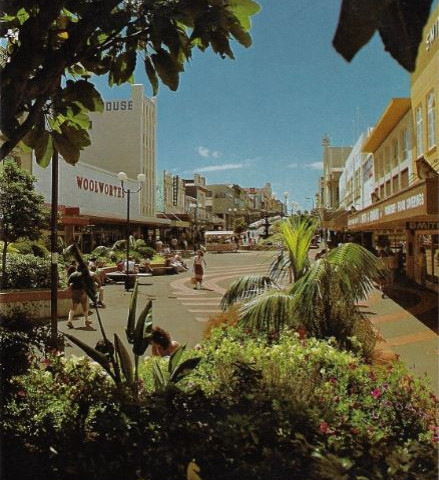11:4
One of Arthur Standish's early partners was Robert Clinton Hughes who became a member of the Provincial Council and was instrumental in introducing many ordinances, one of which set aside Government land for the purpose of a park in New Plymouth-the genesis of Pukekura Park. His nephew, Leonard, also practised for many years in the firm's Brougham Street offices where among the many treasured documents was a parchment title deed to the home of the Rev. John Whiteley, dated June 10, 1865, signed by Governor Grey, as was a conveyance from Thomas Smith to Whiteley which bore the Methodist missionary's signature. When Clinton Hughes died in 1935 in his late 80s he was the oldest practising solicitor in New Zealand. Indeed, age seems to have been no reason for retirement for New Plymouth lawyers. At 82 Francis Stanley Grayling, who began his legal career with Claude H. Weston's firm as a young man, was still engaged in legal work when he supplied much of the material in this chapter. His career was interrupted by service in World War One; he qualified as a lawyer in 1925 and for the next 55 years practised with distinction in the city. He was also a borough councillor, chairman of the Library Committee and the Fitzroy Beach Committee and for eight and a half years was deputy-mayor. His father, Francis Mallet Grayling, was a builder responsible for many of the bridges built in Taranaki during the early years ofthis century. His grandfather, William Irwin Grayling, was a chemist who ministered to wounded soldiers during the 1860 hos- tilities, and who later taught at a school on a site behind the present Royal Hotel. He wrote a short history of ' The War in Taranaki' in 1862 and 'Taranaki And Its Resources' in 1886, both of which have become collectors' pieces. Oliver Samuel began practice in the town in 1870. He assisted Arthur Standish in the prosecution ofTe Whiti and Tohu at 'the Parihaka State Sedition Trials' in 1881, and the following year prosecuted Wiremu Hiroki who was hanged in New Plymouth Jail for the murder of John McLean near Patea in 1878, following his arrest with Te Whiti. Samuel was also engaged at the trial of Mahi Kohi, whose sentence to death for the murder of Stephen Maloney in Pukekura Park on April 11, 1890, was commuted to life imprisonment. Among the many outstanding civil cases in which Samuel was engaged was the harbour board sinking fund case of 1886.
The board at that time was in big financial trouble. Oliver discovered that many years before the board had paid to its sinking fund commissioners large sums beyond those which it was bound by law to pay. He advised the board to test the question in the Supreme Court, and Mr Justice Ward ruled that the sinking fund commissioners should refund more than $40,000 to the harbour board. The grateful board thanked Samuel for his unremitting diligence ... 'a celerity we believe unprecedented in New Zealand, still more so in England.
Samuel always had a keen desire to see the oil resources of New Plymouth exploited and spent thousands of dollars to this end. In 1884 he was elected to Parliament; in 1907 he was appointed to the Legislative Council and in 1920 was made a KC. He died five years later. Weston is another name prominent in New Plymouth legal history. Thomas Shailer Weston practised in the town for only a few years after 1861, then at Invercargill and at Auckland when, in 1873, he was appointed a district court judge at Napier. He retired from that position and returned to legal practice in Christchurch. He died in 1912. His son, also Thomas Shailer Weston, practised in New Plymouth before moving to Wellington. Another member of this legal family was Claude Horace Weston who was known to many World War One soldiers as Colonel Weston. For many years he acted as Crown Solicitor in New Plymouth before he took silk in Wellington. 'If a lawyer's hand is fee'd, sir; he steals your whole estate.' John Gay's comment in The Beggar's Opera epitomises the fears of lawyers held by many lesser mortals. The legal profession guards its reputation zealousy. The discipline of lawyers is in the hands of the profession itself, and the disciplinary committee of the New Zealand Law Society can (and has done) refer cases of transgression to the police, and has power to strike a practitioner off the rolls, fine or suspend him, or refer his offence to the courts. Perhaps one of the most sensational inquiries into alleged offences in New Plymouth was that conducted by a Royal commission in 1889, when charges affecting the conduct of Charles Edward Rawson, district judge and stipendiary magistrate, were heard. The inquiry was held at the request of Rawson following a public meeting called by a former Mayor, William Bayly, after a deputation of prominent citizens had alleged that Rawson had been partial in the administration of justice. The meeting was a 'turbulent, even riotous affair' 23 attended by five or six hundred people, and ended in a disorderly fashion with the following resolution, moved by Arthur Standish: 'That in the opinion of the meeting, Mr W. Bayly acted in the true interests of the people in requesting the Minister of Justice to remove Mr Rawson, the District Judge and Resident Magistrate, from this district.'
The commission sat for several days. The nub of the matter was that Rawson had been unduly influenced in his administration by Oliver Samuel, MHR. Other charges brought against Rawson involved drunk- enness. Samuel, a very able lawyer, exerted wide influence, and other lawyers in New Plymouth, particularly Standish, R. C. Hughes andJ. B. Roy, 'had possibly found it difficult to stand up to him. Sir Robert Stout appeared for Rawson and E. G. Jellico, 'the famous (perhaps indeed notorious), lawyer of Wellington for some of the complainants. Violent exchanges took place. At the end of the protracted hearing the commission's report, which received nationwide publicity, completely vindicated Rawson in every respect, including the charge of drunkenness. The Canterbury Press described the charges as 'frivolous and outrageous, a pitiable travesty of grave and serious proceedings and a farrago of unsupported idiotic nonsense.' There was little' idiotic nonsense' about charges brought against other erring lawyers. Perhaps the most notable of these were charges of irregularities with misappropriation of client' funds against Ian Roy, a son of J.B.Roy, in the early 1940s. The case raised great public interest when it was heard before the Supreme Court in New Plymouth. Roy was sentenced to a term of imprisonment, and as a consequence was struck from the roll. The borough council has not been immune to prosecution. In 1932 the Audit Department challenged the legality of the council supplying electricity to Waitara and Inglewood, which it had done since 1924. The Taranaki Electric Power Board raised objections, and the two bodies agreed to have the question of supply to Waitara tested in court. The Supreme Court found in favour of the council, but that decision was reversed upon appeal by the board which successfully argued that Waitara was not an adjoining area within the meaning of the Act. The Council took the matter to the Privy Council, which dismissed it. In May, 1948, a young borough council cashier, Bruce Norman Guilford, was charged in the Magistrate's Court with the theft of $35,000 from the council over a period of five months. Ralph Ernest Pickering, an assistant cashier, was charged with theft and with aiding and abetting Guilford. During the lengthy trial the theft charges against Pickering were dropped, and after pleading guilty to forgery and uttering duplicate bank lodgement slips, he was sentenced to nine months' reformative deten- tion. Guilford pleaded guilty and was sentenced to four years' reforma- tive detention. In a unique case 'The Mayor, Councillors and Citizens of the Borough of New Plymouth v. the King'26 in 1950 the council took action to recover the money. It alleged breach of statutory duty and negligence by the Audit Department as a result of defalcations in the treasurer's department.
The court found no breach of statutory duty, but said the district auditor was guilty of negligence in the way in which the long-delayed work was performed. He should have discovered the dishonesty and warned the employer.>? The court awarded the council $16,338, which on appeal by the department was subsequently reduced to $10,290. Councillor James Whittington Darby and two tradesmen, Charles Robert Cook and Stanley Wallace Hogarth, were found guilty on a charge of fraud in 1949. It was claimed they obtained $175 from the council by falsely representing the money was payable in respect of work done at the East End Reserve, which was unlawful because Darby, who had an interest in the contracts, was a councillor. The case aroused wide interest because it was the first to be brought under the Local . Authorities (Members' Contracts) Act, which prohibited contracts between local bodies and companies in which a council member had a financial interest. In March, 1950, the Court of Appeal quashed the convictions, and ordered a retrial which resulted in acquittal of the three men. Darby, who had been chairman of the electric light and tramways committee, then resigned from the council because he said the long leave of absence during the case had left him out of touch with affairs.
New Plymouth's present courthouse is an imposing two-storey building set back from the Robe Street gardens, flanked on the south by the police station and on the north by the Atkinson Building. It is the fourth centre of legal proceedings in the town since the first 'courthouse,' the little wooden magistrate's office on the slopes of Mount Eliot, which was opened in 1841 and was burnt down in 1859. When the Provincial Council centre was built in Brougham Street the upstairs rooms were set aside as a courthouse and an office for the resident magistrate. This was a time when Brougham Street was the town's main thoroughfare, and often the judge called on his bailiffs to go outside and stop interfering noise. For 30 years justice was administered under these unsuitable condi- tions, until in 1895 C. Cliff won a tender to build a new courthouse in Robe Street for $3754, to the design of architect P. G. Smith. The Taranaki Herald commented: 'The design of the building is rather of a mixed order, the Queen Anne style predominating ... There are three departments, consisting of two wings and a centre chamber which is the courthouse itself ... each of the rooms in the wings is fitted with "gasaliers" and ceiling and side ventilators.' On April 3, 1895, Chief Justice Conolly presided over the first Supreme Court sitting in the new centre and noted that as far as he could see the building and conveniences were suitable for the court's business. For 72 years it was the centre of justice in the town, amid growing complaints that it was noisy, draughty, too small and generally out of date the early 1930s suggestions were made for its replacement, but the depression and World War Two interfered.
Work on the present building began in 1964; it was completed at a cost of$258,962 three years later.


